Garden Glimpses April 2021: Paying Attention
I love flowers. Not just the blooms, their whole process of unfoldment. Spring flowering bulbs really embody this, as we watch the first tentative emergence of their leafy tips, often while winter still holds sway, giving way to graceful stems and swelling buds held aloft. Starting off slowly at first, at some point critical mass is reached, and the bud bursts into a full-fledged bloom, sometimes within hours. For many varieties, the transformation continues, as the blossom’s initial hue alters over time, deepening, fading or blushing, requiring a daily viewing if the full effect is to be absorbed. In that way, spring flowers teach us a lesson of paying attention, mindfulness, being present, lest any precious stage in their development escape our notice.
I have an increasing number of these types of bulbs in my garden, most of which I have not been familiar with before, and as April waxes each day unveils another surprise, a new vista, an unlooked-for treat.

As a small child, starting late in February, whenever the ground reappeared from beneath melting snows, my mother would take me in tow and lead me about her garden, looking for the earliest signs of spring. Her excitement when she observed the first green fingers poking through was contagious, and I quickly learned to differentiate crocus from daffodil, tulip from hyacinth or bluebell, in the foundation plantings which circled our house. That’s my house now, and my mother would doubtless be shocked, though I hope pleased, at all the new areas available for such springtime explorations, with the old back and side yards fenced in, the lawn removed, and planting beds installed.
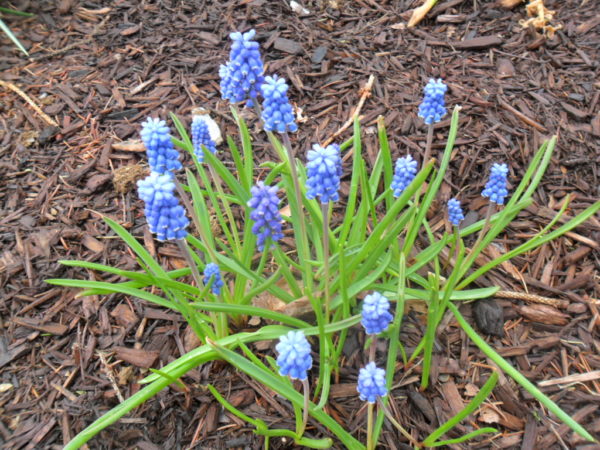
My father also encouraged me to find the beauty in the process, rather than simply the end result. When we went to the grocery or the nursery to look for plants as gifts for mom at Easter or Mother’s Day, annuals to be bedded out in the summer, or a vivid chrysanthemum to accompany our autumn pumpkin on the porch, my eye went eagerly to the rows of flowers in full, glorious bloom, so radiant and luxurious. But dad explained that, if we bought them in that stage, they’d be gone in a few days. On the other hand, if we selected those not as showy, not as fully mature, we could have weeks of following their progress from bud to blossom, enhancing our enjoyment of their loveliness.
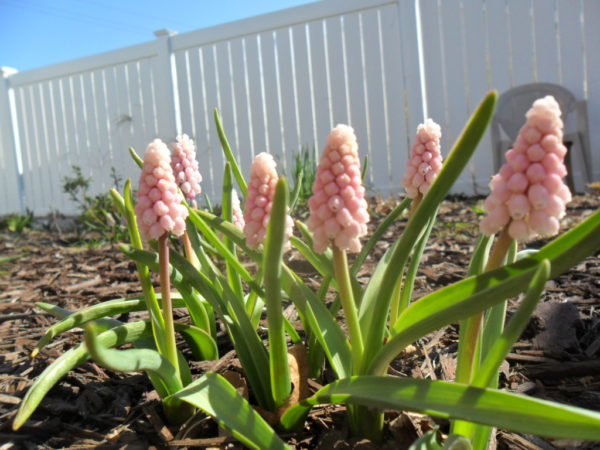
I continue to follow those examples they set (if not many others) and am continually rewarded for my curiosity and patience. As I sat poring over bulb catalogs the past two summers, I thought of old favorites to populate my garden, yes, but I wanted new friends as well. Plants that could become the signature of my own style, and in time, classics of my garden. Always drawn to something a little different, somewhat exotic, or downright unusual, I found plenty of fodder for my spring bulb passion.

For instance, in my youth, bluebells were just that – blue! Charming and cheerful, these were a staple of my mother’s garden, and many stands still exist on the property from that time. But the universe of bluebells, botanically christened muscari, is far wider. I found white “bluebells” several decades ago, blanched but otherwise identical versions of the originals, but couldn’t keep them in the too-shady conditions of my homes in Philadelphia; they invariably died out after a couple seasons, starved of the light they needed to replenish strength to their bulbs.
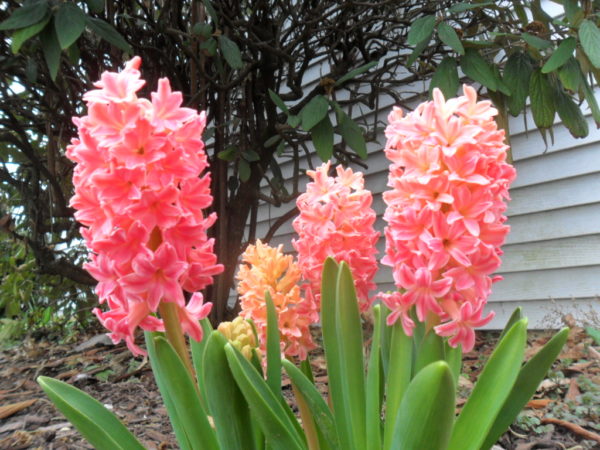
In the fall of 2019, I planted dozens of new muscari, including classic blue, a paler blue version, and a stunning tricolor form, with deep blue at the base, pale blue in the middle, and a crown of white! But somehow, unaccountably, I forgot to order the pure white muscari! So last year I went back to rectify my error, and found additional options I’d never seen before (John Scheepers is my supplier of choice, and has hundreds of unusual offerings of all kinds of spring bulbs). Muscari “Pink Sunrise” looked too wonderful to resist, and I’ve been very pleased with their performance, forming small islands of pale rose-colored blooms which slowly fade to pink-blushed cream. For pure white I chose “Siberian Tiger”, now just starting to thrust its buds skyward, and also invested in a yellow-green variety, “Golden Fragrance”, whose leaves emerge reddish, then turn green before buds are set. These are still in their early stages yet, but I can’t wait to see what they offer!
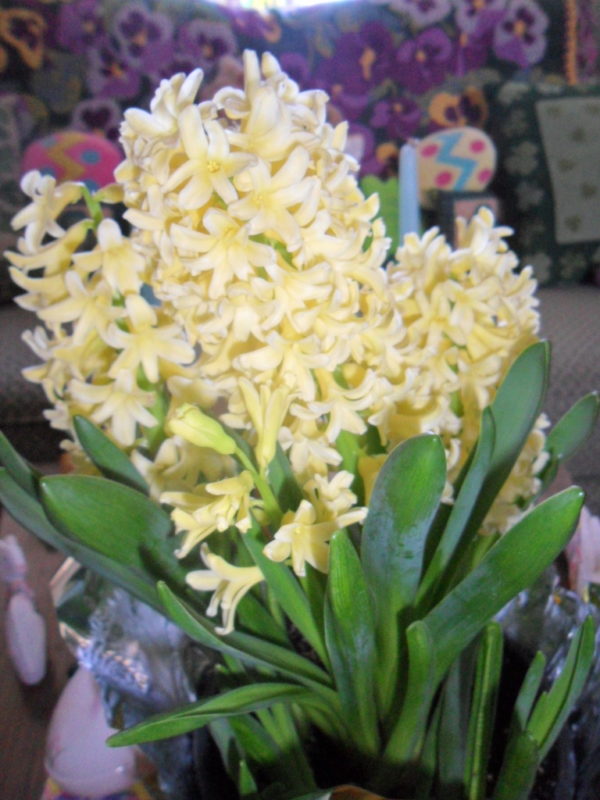
I also inherited a fair amount of hyacinths, mostly the traditional blue, but also some in white, pink, and lavender, relics of Easters gone by, the plants retrieved after the holiday from relatives’ graves which they had graced. I enjoy these reliable heirlooms, but my heart has always gone to “Woodstock”, a vivid burgundy-mauve variety which, again, I never had enough sun to thrive.
]


I waited to acquire these until year two, hunting for just the right space for them; when I found it, I realized that patch could accommodate many more, so I opted also for “Gypsy Queen”, an apricot hyacinth I’d flirted with a few times, and augmented that with “Sweet Invitation”, a stunning pink variety. These are up and doing well now, and in awhile I’ll be adding a pale yellow number to the mix, which I bought potted and budded at a garden center a few weeks ago; these reminded me so much of the yellow hyacinths my grandmother grew next to the driveway when I was a child, I simply had to have them!

Other small bulbs have been fun to watch as well. Last year the stands I planted of white or blue scilla were completely decimated by the rabbits before they ever opened. The wee varmints took everything, leaf, stem and bud, and I feared that would be the end of them. The fence has been cat-proofed since then, with a berm built up to close the gap beneath it, and so far, that seems to be working for the rabbits as well; there has been no fresh depredation this year.

The blue scilla returned but spottily, and very small, just one or two star-like blossoms per bulb. The white did much better, about 90% returned, and though they are well behind where they ought to be, they made a brave effort. But it will be years before my original vision is fulfilled, of a triangular sea of foamy white scilla bounded by golden beaches of tete-a-tete daffodils.
\
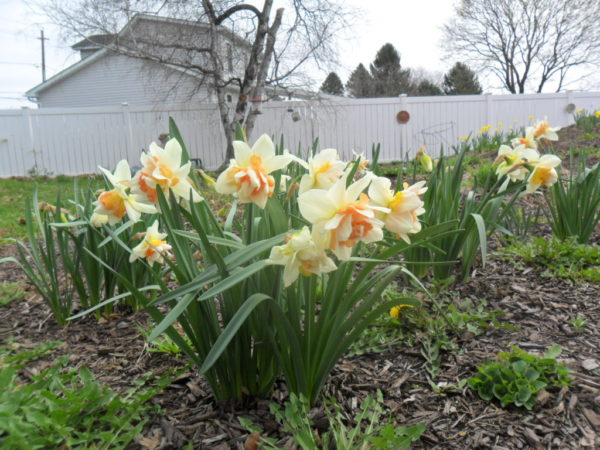
However, I did invest in new scilla of both types this year, and those have really thrived. Just a few clumps of each, but lovely islands of color. The blue scilla was especially nice to see, since its earlier attempt was so disastrous. The white is actually a different cultivar, and one I now prefer – much sturdier, fuller, with larger blooms.


Another old friend I welcomed back with open arms is Fritillaria Uva-Vulpis; yes, that’s quite a mouthful, so why don’t we just call him “fox grape” and leave it at that? This unique flower is quite a conversation piece. Rising on willowy stems, the bud does a hairpin turn at the tip and the flower opens downward, like a bell. The color is unusual, also – a sort of dusky purplish-brown, it is edged in bright yellow, with indistinct golden midribs that fade into the overall color of the petal. I grew fox grape decades ago in Philadelphia, but like most things in that garden they couldn’t stand the shade, and expired after a few seasons.
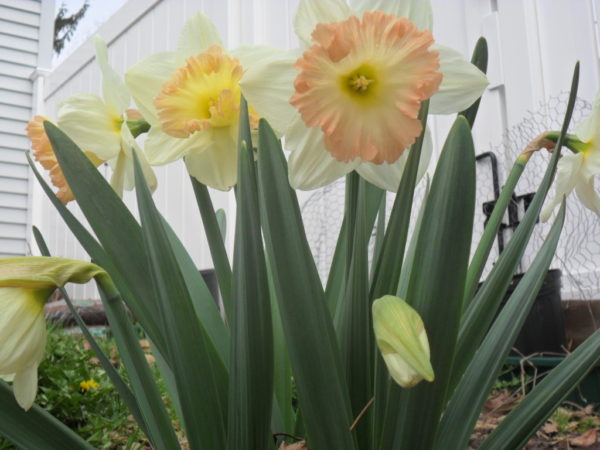
Of course, my focus for this property has always been daffodils, botanical name narcissus, my absolute favorite spring-flowering bulb. These originated in the Mediterranean basin with just a handful of varieties, but breeders have been after them for centuries, and there are literally hundreds of cultivars available now, with more added regularly. For my parents’ thirtieth wedding anniversary, I bought a collection of 50 mixed daffodils, and surreptitiously planted them the autumn before, while they were on vacation in Florida for a week. The next year, mom did her usual late winter garden tours, and was completely mystified, then delighted, by all the unexpected leaves emerging! Many of those old stands were still thriving on the property when I inherited it, but I have considerably added to that total. More than 1500 bulbs have been planted since the fall of 2019, over half of them narcissus.

Some of those initial plantings are beginning to fill in well, others more slowly. Extravaganza, a double daffodil with an allegedly pink interior petal array (it’s more like apricot to my eye, but still lovely) has really taken off, but the drifts of mixed daffodils for naturalizing look more like polka-dot prints. But my Master Gardener Lori’s clumps from last autumn are quite stunning.

I began this article by discussing flowers which alter their hues as they mature, and there’s no class of spring bulbs that does this more aggressively than daffodils! So I’d like to introduce you to Tom Pouce, a dapper gent who opens with medium yellow petals surrounding a slightly deeper yellow cup, only to have that cup age to peach, finishing as an almost coppery color that is quite unique among my plants.
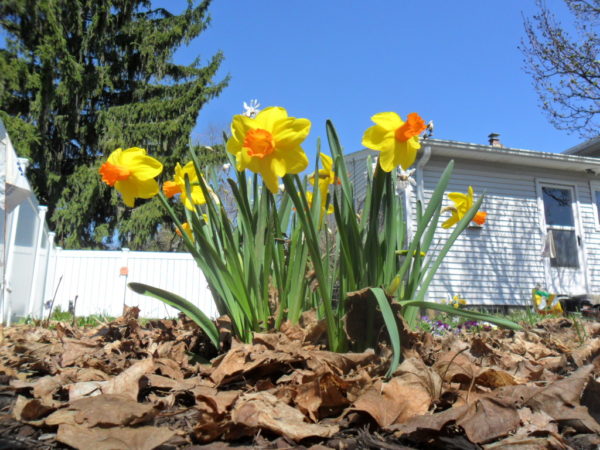
In contrast, Barrett Browning, named for the Romantic poet of the 19th century, inverts that pattern, and starts with butter-yellow petals that blanch to cream, all the while retaining foreshortened, red-orange cups in their original color.
I’m on a Grail Quest for a truly vivid pink daffodil, and so far, not having much luck (though I always enjoy the hues of what I thought would be pink). I already mentioned Extravaganza above, which was pictured in the catalog as hot pink, but in practice is apricot. Another failure in that department, though lovely for itself, is British Gamble, a massive-flowered daffodil with white petals and an elongated pink cup, on which I took a flyer last autumn that didn’t pay off, at least as far as satisfying my desire for pink is concerned. This is another narcissus which does a wardrobe change mid-bloom; the inner surface of the deeper portion of the cup emerges as pale yellow-coral, then fades to pale pink cream, while the edges of the cup remain static in hue. I might call this color “rose”, if I was in a generous mood, but pinky-pink it definitely is not! Nevertheless, it’s quite attractive, and I’m happy to have it in my garden. But the hunt for true pink goes on …

My all-time favorite, however, is yellow daffs with orange cups; I simply can’t resist them! I inherited one from my parents, name unknown, which returns faithfully every year by the spouting at the southwest corner of the house, fueled into early bloom by the protection the house affords and the solar heat reflected off the pale grey siding.
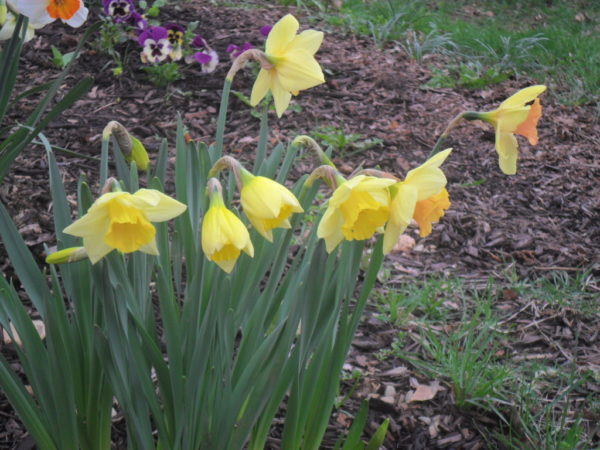
Jetfire is another old friend which I grew in several incarnations over the years in Philadelphia. A miniature daffodil like tete-a-tete, Jetfire’s blooms are somewhat larger, its stems somewhat taller, and its reflexed yellow petals have a windswept look, pushing the deep orange cup to visual prominence, as though it is the jet engine and the petals are flames.
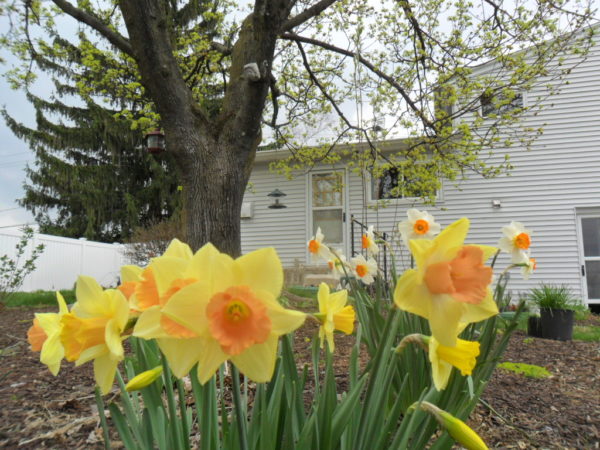
This year I added four new yellow-orange-mixed daffs to the landscape: Classic Garden, Brackenhurst, Bantam and Tahiti. Classic Garden opens first, with bright yellow petals and deep orange cups. Like Jetfire, Classic Garden’s petals reflex, but are more gently curved, almost billowed, giving the appearance of being puffed up from behind by soft spring breezes.
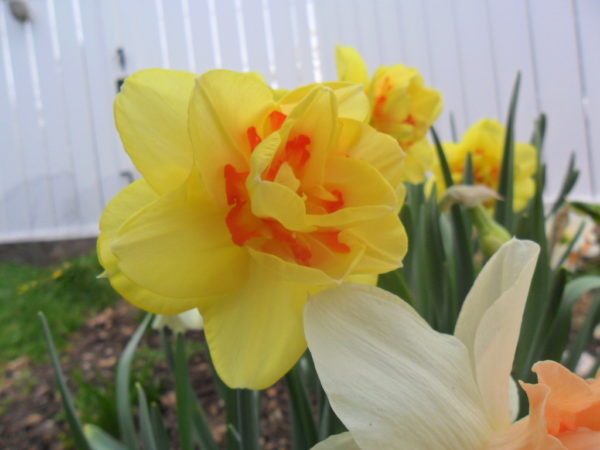
Brackenhurst is a mid-season performer with the same basic color scheme as Classic Garden, but slightly larger blooms. Its petals stand boldly erect, sticking out from the cup at a ninety-degree angle. Bantam is their diminutive cousin; its delicate, medium-yellow flowers are not much more than an inch in diameter, punctuated with “short stack” cheerful disks of orange, but providing anywhere from three to five blooms per stem, for a ready-made bouquet in miniature. Bantam is a late-season bloomer, and just setting its buds in mid-April.
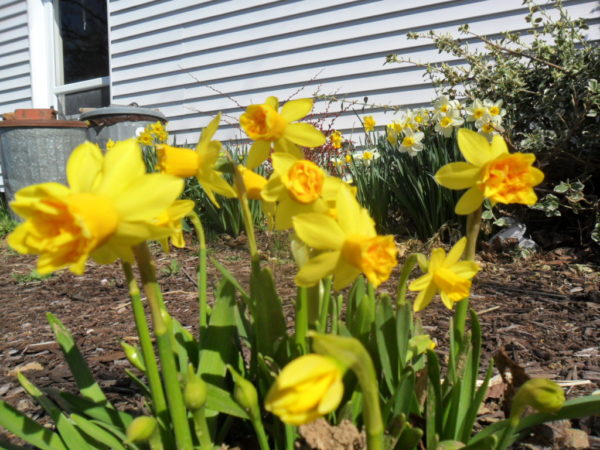
Tahiti is a mid-season daffodil, a double variety, which is to say, there are multiple petals forming an almost fluffy blossom “ball”, some of which are actually “splintered” portions of the cup. So in the case of Tahiti, a yellow daffodil with an orange cup was mutated into one slashed with smaller bits of orange interpolated in a ring around the center of the bloom.
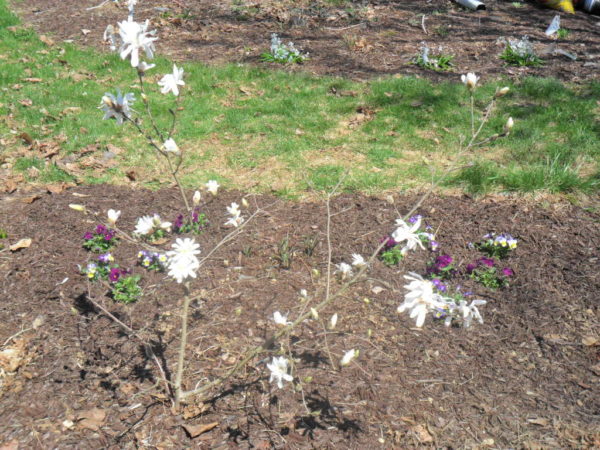
Another new addition to the garden is my Star Magnolia, which I purchased late last summer. This is its first season of bloom here, and though barely three feet tall, it did not disappoint, being covered with several dozen pure white blossoms closely resembling the celestial objects which give it its name. Although among the earliest ornamental trees to bloom, magnolias of any variety are notorious for the vulnerability of their flowers, which are susceptible to browning with frost or freeze levels of cold, or shattering if exposed to heavy rains. But when the Fates are with you, magnolia puts on a show not to be equaled in the April garden.

This year we did get two consecutive nights of sub-freezing temps, but thankfully only a pair of blossoms were at that point fully opened, the rest being more or less protected in the bud. These did indeed brown, but were quickly replaced by more, until a passing shower knocked several others into white shards on the mulch below. That rain downed more than few daffodils and hyacinths as well, particularly the ubiquitous Extravaganza, which are naturally top-heavy with their doubled blossoms. But my dear friend Martha has a formula for that misadventure: “rain + daffs/hyacinths/heavy flowers = vases.” My Depression-era mother would have approved of that “waste not, want not” mentality.

As we entered mid-month, the maple buds swelled and exploded into masses of chartreuse fireworks, while the paper birch dangled its yellow-green catkins provocatively and sent forth the first infinitesimally small lime-colored leaves. These are some of my favorite sights in the spring landscape. Everywhere shrubs are leafing, perennials emerge from their long winter slumber, birdsong fills the skies and early pollinators seek out the choicest morsels from the banquet that is just beginning.
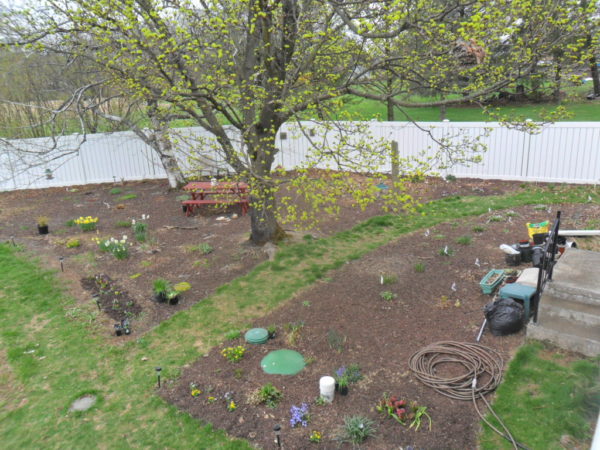
And so April in the garden rolls on …
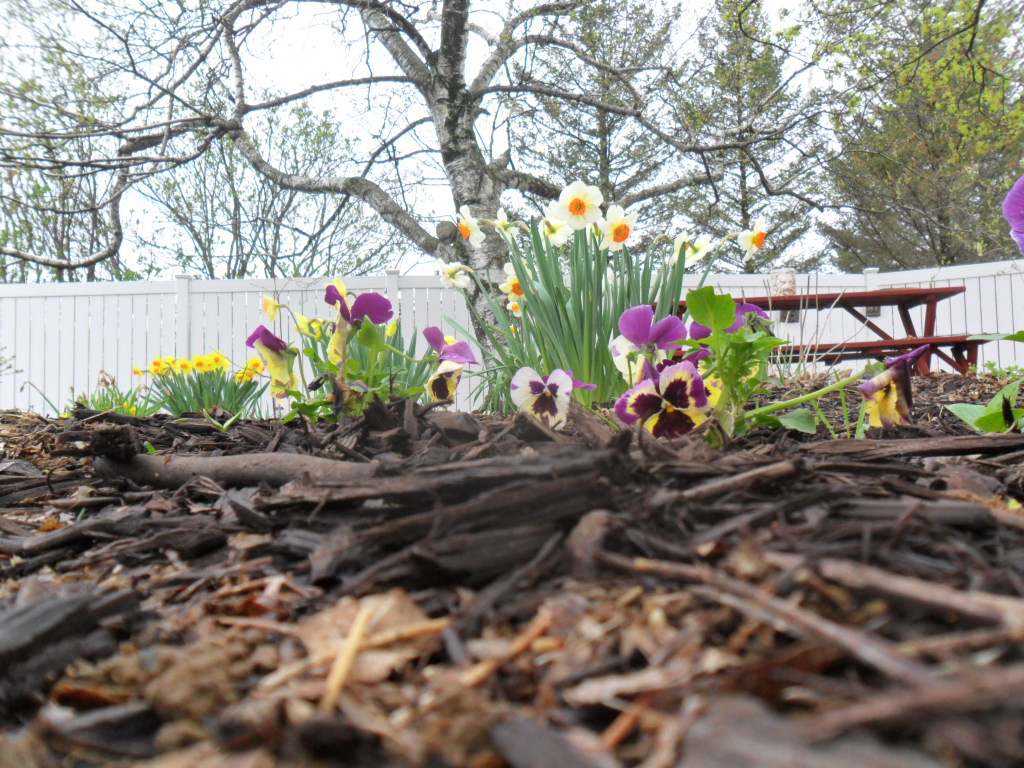

3 comments, add yours.
edna
Love it – thank you for sharing!
Laurien
Loved the pink sunrise muscari and the exotic shades of hyacinth! I’ll bet the hyacinths makes your garden smell lovely too! What a wonderful gift of 50 “surprise” daffodil bulbs for your parents’ anniversary! Thanks for sharing your garden adventures!
Liz Cheyne
Thanks for this gorgeous post Alex – I love flowers/gardening too and my English- born mother used to take us round the garden too – exactly as yours did ( we were in NZ) . These beautiful pictures have totally brightened my day 🙂